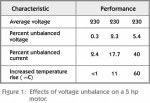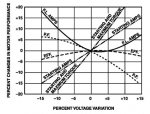We have a new tank farm pump installation with three 40 hp pump motors that are rated at 230/460 volt 3 phase, 1780 RPM, 90/45 amps. We are using soft starts. The voltage with no motors running is phase to ground 288, 289, and 289 and phase to phase 500, 500, 504. With one motor running the voltage is 283, 284, and 285 and phase to phase 492, 492, and 495. The current is 50, 52, and 46. Rpm is 1790. The other two motors are close to the same except lower amps due to lower head pressure at the time. I rotated the conductors on the load side of the starter and saw no change. I see no difference in the readings on the line side and load side of the starter.
We originally set the overloads at 45 but had to set them higher to keep the motors running.
Motor manufacturer doesn't have much for ideas on why we have this current imbalance. Motors are cool running, sound good and move product very well.
Should we be concerned?
We originally set the overloads at 45 but had to set them higher to keep the motors running.
Motor manufacturer doesn't have much for ideas on why we have this current imbalance. Motors are cool running, sound good and move product very well.
Should we be concerned?



